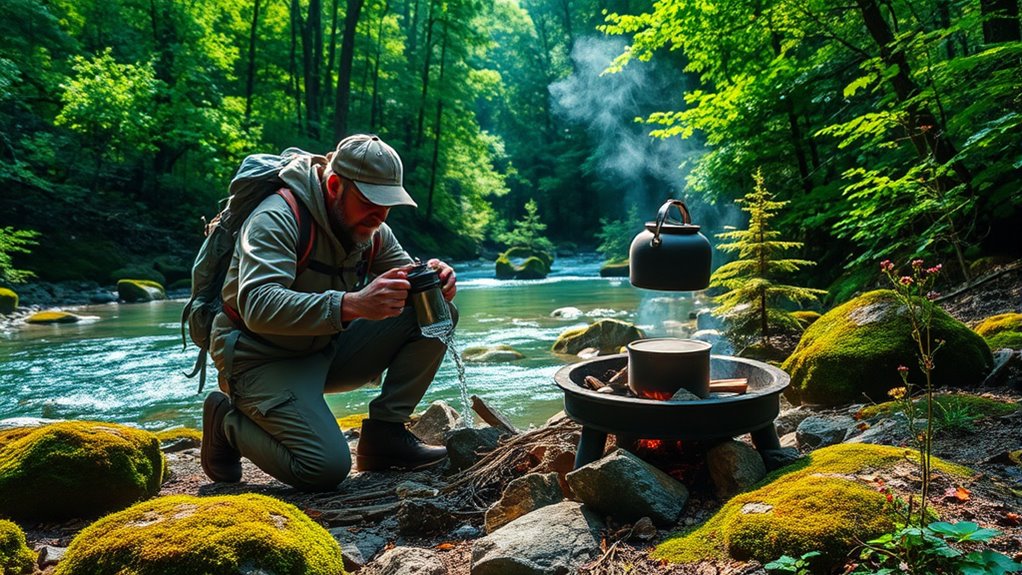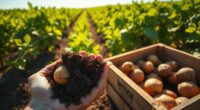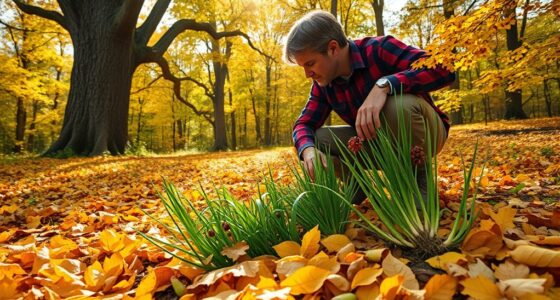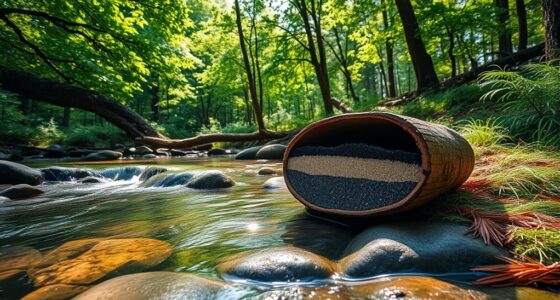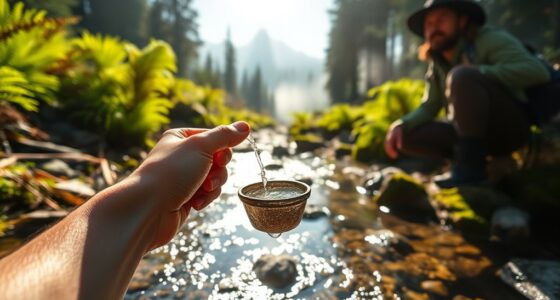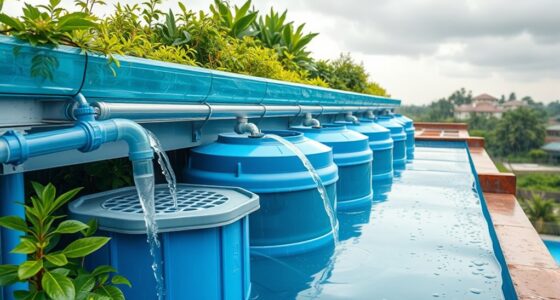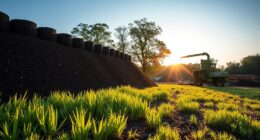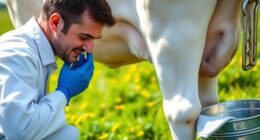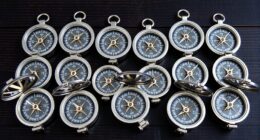To make safe drinking water in the wilderness, first locate water sources by observing vegetation or animal tracks. Purify the water using boiling, chemical treatments, or portable filters. Boil for at least one minute to kill germs, or use chlorine tablets while waiting the required time. Always be cautious of contamination from wildlife and avoid stagnant water. For specific conditions, adapt your methods accordingly. Keep exploring to discover the best practices for water safety in the wild.
Key Takeaways
- Boil water for at least one minute to effectively kill harmful microorganisms and ensure safety.
- Use portable filters to remove pathogens, but combine with boiling for virus protection.
- Employ chemical disinfection methods like chlorine or iodine tablets, allowing necessary wait times.
- Start with sedimentation to settle larger particles before filtering and boiling for murky water.
- Always treat clear water before drinking, as it may still harbor unseen contaminants.
Finding Water Sources in Various Environments

When you're out in the wilderness, knowing how to find water sources in various environments is crucial for your survival.
In forests, look for green plants and listen for the sound of running water, which often indicates nearby streams or rivers. Follow animal tracks, as they can lead you to water sources.
In deserts, focus on cacti and shrubs, as these plants thrive near water. Birds and wildlife can guide you to hidden oases.
In mountainous regions, meltwater from snow and ice is reliable, and fast-moving streams are cleaner. Keep an eye out for springs and alpine lakes.
Effective Water Purification Methods

Although finding water in the wilderness is vital, purifying it's just as essential to ensure your safety. Boiling is one of the simplest and most effective methods; just boil the water for at least one minute to kill harmful microorganisms.
If you have a portable filter, it can remove pathogens down to 0.2 microns, but remember that it may not eliminate viruses. Chemical disinfection using chlorine or iodine tablets can also work, though you'll need to wait for them to take effect.
For additional methods, consider using sedimentation to settle out larger particles before purifying. Always combine methods when possible, like pre-filtering with cloth before boiling, to enhance safety and taste.
Essential Equipment for Water Purification
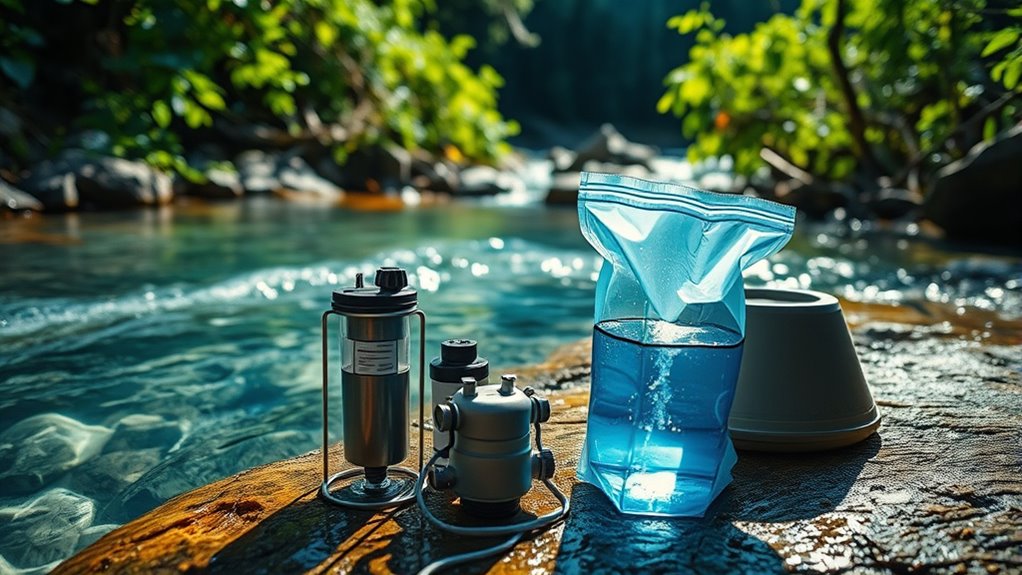
Purifying water in the wilderness requires the right equipment to ensure safety and efficiency. For solo hikers, squeeze filters and chemical treatments are lightweight and portable, making them perfect for individual use.
If you're part of a group, consider gravity filters like the Platypus GravityWorks, which offer high flow rates with minimal effort. For emergency situations, boiling is straightforward and effective, needing just a heat source and container.
UV purifiers are battery-operated and tackle bacteria and viruses efficiently. Don't forget to maintain your gear—regular cleaning and checking seals are crucial for optimal performance.
Investing in durable, versatile filters like the MSR Guardian can be beneficial, especially in high-risk areas or cold weather.
Safety Considerations for Drinking Water

Ensuring safe drinking water in the wilderness is crucial, as contamination can come from various sources like wildlife, human activities, and agricultural runoff. Untreated water can lead to illnesses such as gastroenteritis and diarrhea, so it's vital to assess water quality carefully.
Clear water might look inviting, but it's not always safe; always treat it before drinking. Avoid stagnant or cloudy water, especially if it has visible scum or debris. Be cautious of water sources near dead animals or human settlements, as these are likely contaminated.
Lastly, remember that vulnerable groups, like the elderly and pregnant individuals, should be particularly cautious about water quality to avoid severe health risks. Always prioritize safety when sourcing your drinking water.
Techniques for Specific Wilderness Conditions

When you're in the wilderness, the techniques for obtaining safe drinking water can vary significantly based on the environment.
In tropical areas, distillation removes excess minerals, while coconut water provides hydration and purification materials.
For cold conditions, boiling is your best bet, and chemical treatments can be handy, though they might taste off.
At high altitudes, you'll need to extend boiling times due to lower temperatures, and portable filters work well.
At high altitudes, remember to boil longer and utilize portable filters for safe drinking water.
In deserts, distillation and immediate purification are crucial since water is scarce.
Lastly, when dealing with murky water, start with sedimentation and filtration, then follow up with boiling and chemical treatments to ensure it's safe.
Always adapt your methods to the specific conditions you face.
Best Practices for Wilderness Water Safety
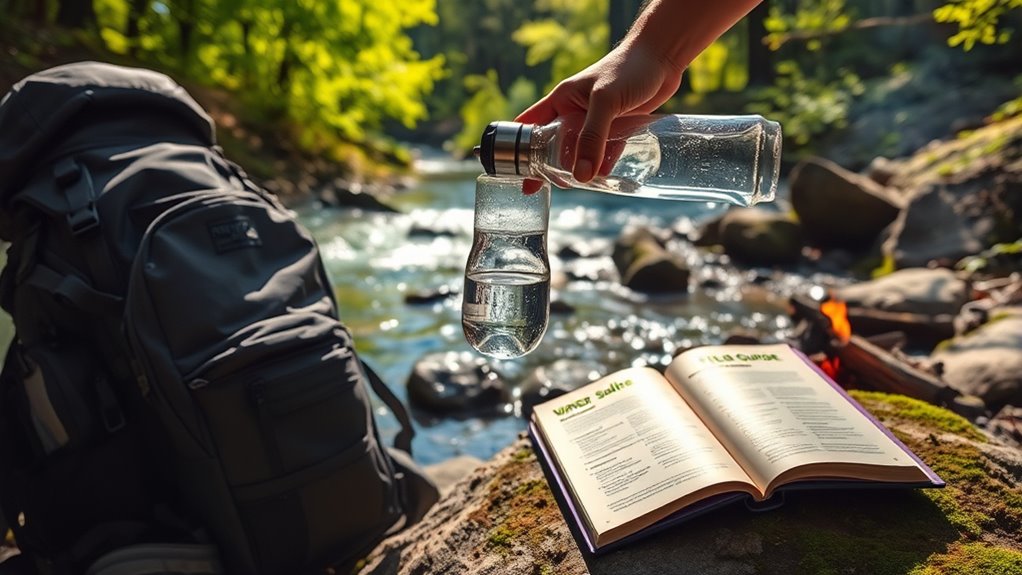
Although accessing clean water in the wilderness can be challenging, knowing best practices for water safety is essential for your health and well-being. Always assume natural water sources are contaminated.
To purify, boil water for at least one minute, or use makeshift filters to remove particulates. In emergencies, prioritize the cleanest available water source. Look for vegetation indicators and animal tracks to locate potential water sources. Collect rainwater or melt snow when possible.
Additionally, supervise children closely around water and avoid swimming alone. Use U.S. Coast Guard-approved life jackets when boating. Be aware of water conditions, including currents and temperature, to ensure your safety and enjoyment during your wilderness adventures.
Frequently Asked Questions
How Can I Identify Safe Water Sources in Unfamiliar Areas?
To identify safe water sources in unfamiliar areas, start by observing the vegetation; lush greenery often indicates water nearby.
Follow animal tracks, as they usually lead to reliable sources.
Keep an eye on bird behavior; low-flying birds may signal water.
Check the topography for valleys or streams, which are likely to have cleaner water.
Always assess the water quality by looking for signs of life and contaminants before considering it safe to drink.
What Are the Signs of Contaminated Water Sources?
You might think all water looks safe, but that's not always true.
Watch for signs of contamination: dead animals or their tracks nearby signal danger. Stagnant water, unusual vegetation, and bad odors can indicate problems too. If you see oily stains or foam, steer clear.
Even animal behavior can hint at safety—if wildlife avoids a source, take that as a warning. Always trust your instincts and err on the side of caution.
Can I Use Water From Urban Areas Safely?
You can't assume water from urban areas is safe. Contaminants like heavy metals and pesticides often pollute these sources, and treatment systems can fail.
While boiling or using chemical disinfection can help with pathogens, they won't remove chemicals.
If you're unsure, consider alternatives like collecting rainwater or using well water, but make sure to test any source first.
Always stay informed about water safety to protect your health.
How Do Weather Conditions Affect Water Availability?
Weather conditions play a crucial role in water availability.
When you face prolonged droughts, you'll notice a significant reduction in water sources, making it harder to access what you need.
Conversely, heavy floods can contaminate water with sediment and pollutants, compromising quality.
Additionally, changes in precipitation patterns can lead to unpredictable water supply, affecting not just your immediate needs but also agricultural and economic stability in your area.
Always stay aware of these conditions!
What Is the Shelf Life of Water Purification Tablets?
Think of water purification tablets as tiny life preservers, but even they've an expiration date.
Generally, these tablets last 3-5 years if stored properly. Once opened, they can lose potency within a year.
For best results, keep them in a cool, dry place, away from moisture and heat. If you notice any color changes, it's a sign they mightn't be effective anymore.
Always check the packaging for specific expiration dates.
Conclusion
As you venture into the wild, remember that clean water is your lifeline, shimmering like a beacon in the wilderness. Embrace the techniques and tools at your disposal, turning murky streams into crystal-clear sustenance. With every sip, you'll feel the pulse of nature revitalizing your spirit. By staying vigilant and practicing safe methods, you'll navigate the great outdoors with confidence, transforming any trek into a refreshing journey where hydration flows as freely as the rivers around you.

